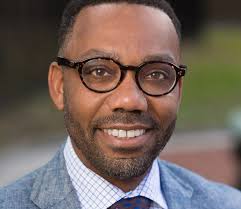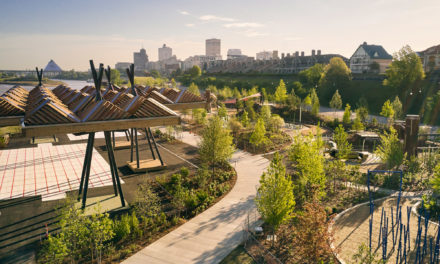This column written recently in CityLab by Andre Perry, fellow at Brookings Institution in the Metropolitan Policy Program and who spoke in Memphis August 8, 2019, as part of Neighborhood Preservation Inc.’s conversations about revitalizing Memphis neighborhoods.
By Andre Perry
The following is an excerpt from Andre Perry’s forthcoming book, “Know Your Price: Valuing Black Lives and Property in America’s Black Cities.”
In 2018, I took a walk through Birmingham, Alabama, with real estate developer Brian Rice. Earlier that year, Rice had purchased nine buildings on 19th Street in downtown Ensley, the largest of the 99 neighborhoods within Birmingham. He was planning to bring them and the commercial corridor they were once part of back to life.
Blighted, vacant buildings interspersed with crumbling, if occupied, storefronts surrounded us. At the turn of the twentieth century, Ensley was its own municipality, with two business thoroughfares — one black, the other white — where merchants sold their wares to people who worked in the nearby steel factory of Tennessee Coal, Iron, and Railroad Company.
Today, only a small number of businesses operate in the former white thoroughfare of Ensley. Half-demolished lots overshadow the occupied businesses in buildings that could very well pass as condemned. Very few people and cars passed us as we walked and talked. On this walking tour of Ensley, we stopped at one of Rice’s buildings that was partitioned into multiple units; it was constructed of brick and wood seemingly held together by decay.
While highly motivated, Rice was clear-eyed about the difficult road he and others must take. He had to kick the door several times to unstick it. When we stepped inside, what I saw inspired me to join the chorus: “Why develop this crumbling edifice?”
Most of the roof had fallen to the floor. Sunlight illuminated the jumbled piles of wood, plaster, brick, and metal that covered the ground. Pieces of tin ceiling tiles dangled perilously over our heads.
The state of the building held a mirror to the unemployment, divestment, and devaluation in the entire neighborhood. To outsiders, Rice, would no doubt seem to have made a bad investment by purchasing, with the help of family and friend investors, nearly an entire crumbling, commercial city block in a low-income black neighborhood. Between 1970 and 2010, the East Ensley neighborhood lost 81% of its residents, the most of any census tract in the city.
When bank lenders and outside observers asked Rice, “Why?” what they saw was the low incomes, high unemployment, and high crime in Ensley. But Rice was not looking at those realities; instead, he focused on its potential.
As we walked down 19th Street, Rice began sharing pieces of his vision. Facing an open area, he said, “I want to turn that into an outdoor pavilion patio-type space. A place for food trucks to set up.”
He pointed out the three accounting firms on the block. He wanted to convert one of the buildings to a place for nonprofits and mentoring programs. He planned to use a walkway between two buildings to host pop-up businesses.
“As you look down the street a little bit more, you will see there’s three more buildings…I want to turn that into a conference space for us and the community.”
Community development for places that have been ravaged by racism calls for multiple investments in people and places at a scale that can truly make an impact. Policies similar to those that created wealth for whites after the Great Depression could be applied again if not for Supreme Court decisions barring racial preferences. For the devalued price on property, there are black developers like Rice who can buy a city block with family and friend investors, but those individuals need financing structures to redress the systemic and historic exclusion of wealth creation in this country.
“It should be easy,” Rice said when describing getting financing to develop the properties he’d already paid for. Rice’s initial investors provided him with the cash to pay for all the buildings. He still struggled to receive a loan from a traditional bank to develop the properties. Six months after the purchase, Rice had been able to secure only $50,000, from a local bank. After an extensive process of sending numerous forms to several banks, the only returns he received were requests for more documents. Rice told me he realized then that “they’re trying to burn me out, but they don’t want to say no.”
Banks account for the majority of real estate development funding. Loans from large banks are the most sought-after source of funding by businesses, regardless of the racial background of owners.
However, white individuals receive more loans and lower interest rates than people of color.
Raise a hand
On June 20, 2019, I testified before the U.S. House of Representatives Committee on Financial Services Subcommittee on Housing, Community Development, and Insurance for a hearing titled “What’s Your Home Worth? A Review of the Appraisal Industry.” Representative Al Green of Texas asked a few pointed questions to a panel of witnesses composed of members of the appraisal lobby as well as me.
“Do you believe that…invidious discrimination plays a role in the devaluation of property in neighbor- hoods that are predominated with minorities, but more specifically black people?” Green asked.
“If you do believe this, raise your hand.”
I was the only one on the panel who raised a hand.
Nonplussed, Green asked another question for fear the panel didn’t understand. “If you feel black people are not being discriminated against when their property is being appraised…kindly raise your hand.”
No one on the panel raised their hand, but many guests (seemingly all white) of the panel seated directly behind the witnesses raised their hand in unison.
Green responded, “Now we’re getting some consternation.”
A few day after my hearing, Brian Rice called me, seething. After eight months, he had finally gotten an appraisal back from his bank.
“The basically said my property is worthless,” he bellowed. The appraisers valued 43,125 square feet of land at $1.04 per square foot. All eight of his properties were compared to buildings such as an abandoned car wash and a rural farm, parcels of land more than 10 miles outside of the city. The reports lists the total value of his block at $45,000, which accounts for $170,000 indicated land and property value minus $125,000 in demolition costs. The low appraisal will make it difficult to get the kind of loan needed to develop an entire block.
Rice alleged that his appraisers intentionally devalued the Ensley properties. According to Rice, the appraisers willfully selected the worst property comparison scenarios, comparing his properties to dissimilar rural parcels more than 10 miles away. The appraisal recommended demolition as the best use, although none of the properties have been placed on a condemnation list by the city of Birmingham.The Jefferson County property tax division had placed a much higher value on the properties than the appraisers. Rice argued that this devaluation is evidence of racism.“I have no choice but to go public,” he told me. “I truly believe the bank is trying to force me out of business and into bankruptcy, so they can get my properties for very low.”Rice understands that knowing your price often means fighting for it.
A confluence of obstacles
According to data from a 2020 report by the U.S. Federal Reserve, black business owners apply for bank financing at a slightly higher rate than white, Asian American, and Latino or Hispanic business owners, but more than half of applications are turned down — a rate which far exceeds any other demographic group.More than half (53%) of black business owners who apply for financing are denied, compared to 25%, 35% and 39% of white, Asian American, and Latino or Hispanic business owners, respectively.
Furthermore, research from the Minority Business Development Agency (MBDA) in 2017 showed that among high-sales firms (those with over $500,000 in gross receipts), white-owned businesses received loans that were worth more than double the amount lent to minority-owned firms, on average ($310,000 to $149,000, respectively). The report also found that minority-owned businesses paid an average interest rate of 7.8% compared to 6.4% for white-owned firms.Rice pointed to the history of redlining in Ensley.
“We’re in an area where banks have chosen not to invest,” he told me. With banks across the area delaying, denying, and not even responding to his requests for loans, Rice was recruiting Community Development Financial Institutions (CDFIs) and banks to open branches in Ensley, which currently has only one bank and one credit union.CDFIs serve lower- and moderate-income individuals or communities by providing accessible financial resources. In 2018, there were more than 1,100 government-certified CDFIs located across the country managing $150 billion in total assets collectively, according to the Community Development Financial Institutions Fund. According to the Opportunity Finance Network, the national association of CDFIs, of those served by CDFIs in 2017, 55% were people of color and 82% had low income or low wealth, or were from historically disinvested communities. Additionally, 27% of those served were from rural communities and 45% were women.
Birmingham, with only two certified CDFIs (at the time this chapter was written) receives significantly less CDFI funding compared to its peers of similar size.
Brian Rice’s development is exactly the kind of endeavor that another type of federal funding — the Opportunity Zone provision of the 2017 Tax Cuts and Jobs Act — is supposed to support.Opportunity zones are a community development tool that give tax relief on unrealized capital gains — profit from the sale of property and other investments — if those revenues are reinvested in a dedicated opportunity fund, which deploys resources in designated distressed areas. Governors identified the low-income urban and rural communities that fit certain criteria designated as an opportunity zone, and there are fund managers across the country who are ready to take in funds to invest in commercial real estate, housing, infrastructure, and even existing and start-up businesses.
However, there are significantly fewer black-owned real estate developments of the size and scale of those owned by other racial groups. In addition, there are a limited number of black and Latino managers of funds from which the investment dollars would be directed. Consequently, the reinvestment of an estimated $6 trillion in unrealized capital gains would not build wealth for the people who need it.
The inability to create wealth within the black community is the reason so many black-majority places are distressed. Nonetheless, Rice’s projects fell outside of the opportunity zone that covers parts of Ensley, precluding him from those investment dollars.
Brian Rice’s development is exactly the kind of endeavor that another type of federal funding — the Opportunity Zone provision of the 2017 Tax Cuts and Jobs Act — is supposed to support.
Opportunity zones are a community development tool that give tax relief on unrealized capital gains — profit from the sale of property and other investments — if those revenues are reinvested in a dedicated opportunity fund, which deploys resources in designated distressed areas. Governors identified the low-income urban and rural communities that fit certain criteria designated as an opportunity zone, and there are fund managers across the country who are ready to take in funds to invest in commercial real estate, housing, infrastructure, and even existing and start-up businesses.
However, there are significantly fewer black-owned real estate developments of the size and scale of those owned by other racial groups. In addition, there are a limited number of black and Latino managers of funds from which the investment dollars would be directed. Consequently, the reinvestment of an estimated $6 trillion in unrealized capital gains would not build wealth for the people who need it.
The inability to create wealth within the black community is the reason so many black-majority places are distressed. Nonetheless, Rice’s projects fell outside of the opportunity zone that covers parts of Ensley, precluding him from those investment dollars.





